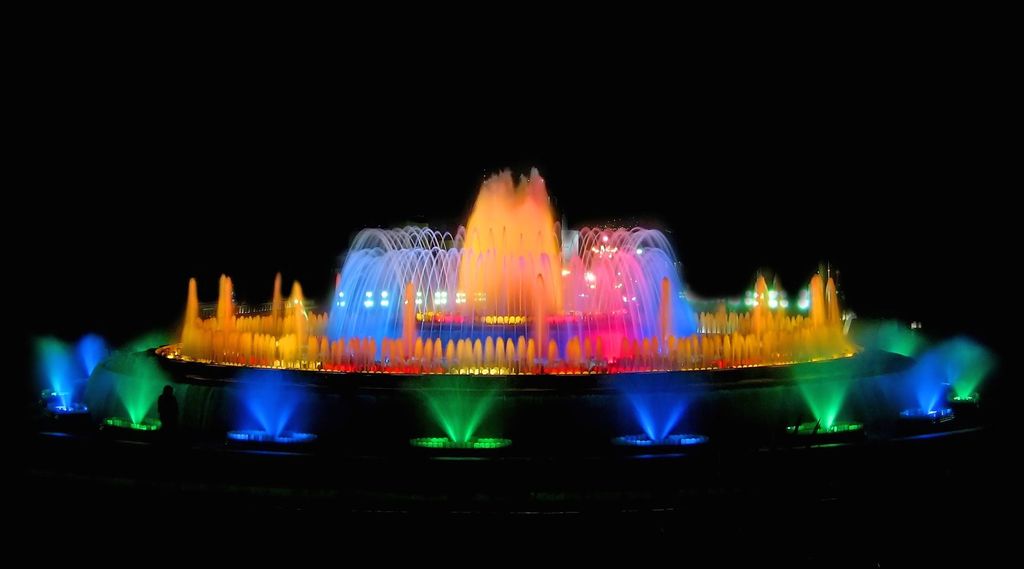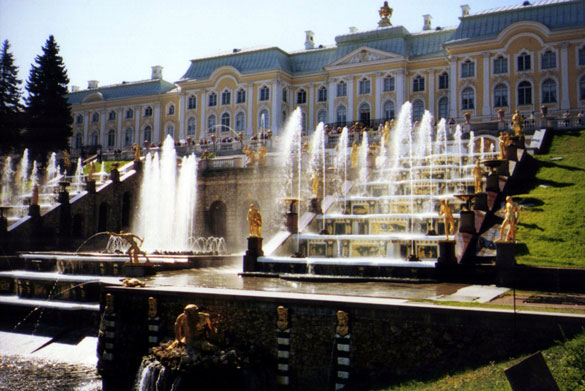The fountain is an integral part of urban art. In many parks, as well as in squares, you can find water composition. It may be the simplest water jet that rises, but often the fountain strikes with its original form. Below are descriptions, photos, names of unusual fountains of the world.
"Boat", Valencia, Spain
A stunning composition located on one of the squares in Spain. In common people, the fountain is called a “boat”, the original name is Fuente del Barco de Agua. At first glance (when the fountain is turned off) it is an uncomplicated metal frame that absolutely does not represent anything. But it is worth running in jets of water, as vacationers see a boat sailing through the sea. It looks especially beautiful in the rays of the rising or setting sun and at night with the backlight on. Many tourists wish to take pictures on the background of such a romantic fountain, as well as make a wish by throwing a coin.
The Magic Crane, Cadiz, Spain
Another famous fountain in Spain is located in the city of Cadiz. Designed by Philippe Till, a sculptor from France, this crane attracts many tourists from all over the world. In fact, the idea of such sculptures with water is simple and, at the same time, brilliant. The composition rests on a metal base, which is hidden from the viewer by a powerful stream of water, which creates the illusion of floating in the air. Now there are a lot of similar unusual fountains (photo in the article) around the world, but it is the “Magic Crane” in Cadiz that attracts the attention of residents from all over the world. And despite the fact that the “secret” of soaring has long been revealed, this spectacle is a delight in both children and adults.
Las Colinas Mustangs, Texas, USA
There is hardly a person in the world who does not know this sculptural composition. Nine powerful mustangs are running, raising spray of water, among the skyscrapers of Texas. Horses are cast in a size exceeding their real parameters by one and a half times. The idea behind the composition is to show the strength, power and rampant state of Texas. The sculptor Robert Glen created about fifty mini-mustangs before finally deciding what his wild horses would be like. The fountain was conceived in 1976, and it was installed in 1984. Bronze figures were cast in England. The water part of the fountain was developed by SWA Group and received the award of landscape architects.
Moonlight Rainbow, Seoul, South Korea
In 2008, in order to attract tourists to South Korea, the ordinary Banpo Bridge in Seoul was turned into a real fountain. Over its entire length (which is almost 1.5 kilometers), almost 200 tons of water are poured into the river from two sides of the carriageway from many special sprayers. Somewhere exactly, but somewhere at an angle, at the same time and in turn to the beat of the sounding music, the jets of water beat in both directions. The spectacle is truly a masterpiece. The fountain works around the clock, but in the dark due to special lighting it looks especially beautiful. I would like to note that the fountain does not deliver any discomfort to vehicles moving along the bridge.
Singing and dancing fountains, Dubai, UAE
The largest singing and dancing fountains in the world are located near the Dubai Mall. The creator is the WET Design group, which also designed the famous fountain in front of a hotel in Las Vegas. Singing fountains are located in a huge artificially created lake with an area of 12 hectares. This is a whole complex of fountains, which simultaneously raises about 100 tons of water into the air. The jets hit a height of about 150 meters, although during testing they raised water twice as high. So special guns “shoot” so high that during the whole show they accumulate water and only splash it up several times. From specially installed speakers, music that does not repeat throughout the day sounds. The repertoire of these unusual fountains of the world (photo in the article) contains about 20 compositions. The show is shown repeatedly over the day, so it’s difficult to miss. At night, the fountain complex illuminates more than 6,000 floodlights. Knowledgeable people are advised to watch the dance of water in the daytime and in the dark.

God the Father on the Rainbow, Stockholm, Sweden
Initially, this sculptural composition, located in a quiet harbor, was developed by the then-famous sculptor Carl Milles. The fountain was supposed to take its place in the square near the UN, but this did not happen. Later, Miles's student Marshall Fredericks nevertheless brought the fountain to life by placing it where it is now. The sculpture is a half of the rainbow, from which water flows in a large stream directly into the expanse of water, and above, God the Father hangs stars in the sky.
Trevi Fountain, Rome, Italy
The famous De Trevi Fountain in Rome is Italy's largest fountain. It adjoins the Palazzo Poli, which makes it seem even bigger and more impressive. The construction of this architectural ensemble has been working for 30 years. Initially, the famous sculptor Gian Lorenzo Bernini took up the project , but the death of the Pope interrupted his work. Further in 1700, Bernini's work was continued by his student Carlo Fontana. It was he who placed in the center of the composition of Neptune with a servant, but death interrupted his plans. And then a competition was announced among the masters of that time for the right to finish work. Nicola Salvi won, and it is he who is considered the creator of Trevi.
One of the most unusual fountains in the world is made in the Baroque style. In the center is Neptune, emerging from the water on its chariot drawn by sea horses and newts. On one side of him stands the goddess of Abundance, on the other - the goddess of Health. Above the goddesses there are bas-reliefs showing scenes of discovering a source of water and building an aqueduct. Thousands of tourists, arriving daily to see the famous fountain, traditionally throw coins, turning their backs on it. Depending on what you want, the number of coins may vary. Every year they bring about 1.5 million euros to the Italian treasury.
Unisphere, New York, USA
The Unisfera fountain was created by Gilmore Clark for the world exhibition, which took place in the middle of the twentieth century in New York. The compositional ensemble is a metal frame of the Earth, surrounded by 96 twin fountains. According to Gilmore, it symbolizes "peace through understanding." The image of the Earth is quite heavy - about 400 tons, made of stainless steel. In addition to Gilmore, several companies took part in the realization of his idea, developing a basin plan and investing their funds.
"Fountain of Wealth", Santek City, Singapore
This unique fountain is located in the center of a huge commercial complex in the city of Singapore. The complex itself is built according to all the laws of Feng Shui, and the fountain is a kind of addition designed to ensure the success of commercial activities. The Fountain of Wealth is one of the largest artificially created fountains in the world. Its area is more than 1.5 thousand kilometers, and the height is equal to a standard three-story building.
This unusual fountain consists of two bronze rings: large and small. The construction of this grandiose building was also carried out according to the rules of Feng Shui, and symbolizes wealth, prosperity, prosperity, harmony. In the center of the ring, jets of water beat, symbolizing a prosperous course of life. The small ring represents the universe and the unity of all living things. According to Buddhist beliefs, the material that the composition consists of attracts financial well-being even more so.
Several times a day, the large fountain is turned off, and visitors are invited to look at the small ring. Tourists are allowed in small groups to avoid crowding. At night, the fountain is also highlighted.
The Grand Cascade, Peterhof, Russia
Perhaps the most famous fountain complex of Peterhof can be called the "Grand Cascade." This is one of the largest compositions of fountains in the world, which has no analogues in terms of water volume, as well as rich design. The “Grand Cascade” was conceived and built under Peter I in order to show the power of the Russian state and emphasize the conquest of access to the Baltic Sea.
More than one sculptor worked on the creation of the "Grand Cascade", and even after the grand opening, the work continued, the complex was supplemented with new figures. In total, there are 255 of them at the moment. The initial view of the fountain differs from that which a tourist can see today: the sculptures were repeatedly destroyed and later restored by restorers. During the Second World War, everything that they did not have time to take out and hide was destroyed. Only thanks to the colossal work of restorers and residents of the city the fountain exists today. During the entire period of its existence, various restoration works have been carried out: for example, the most famous element of the fountain complex - “Samson Tearing the Lion's mouth” - was completed and installed three times.

In fact, you can list the best and most unusual fountains in the world endlessly - they are in every country. It is possible that some very interesting waterworks have not yet become so famous as to be written and talked about, but this will certainly happen. And human opportunities are growing every year. Therefore, the list of the most unusual fountains in the world will be constantly modified and supplemented.